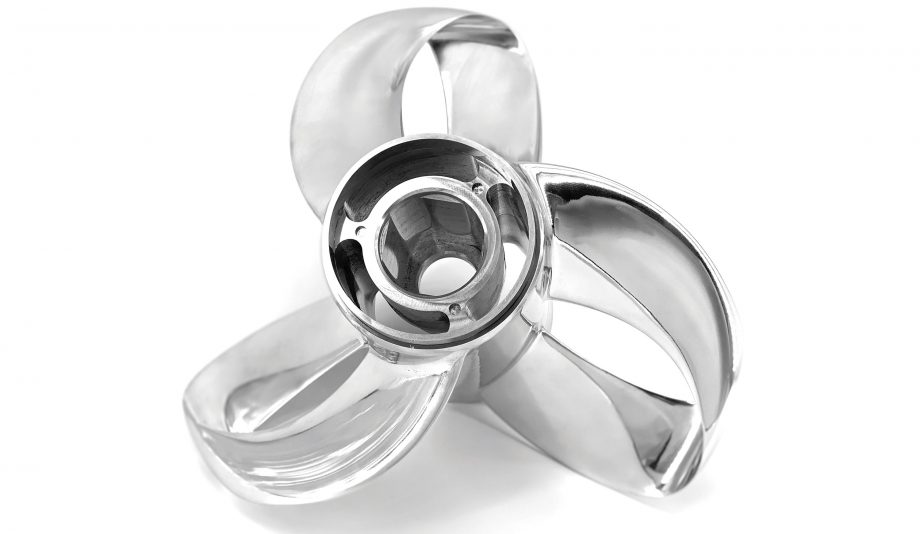Italian start-up Sealence is promising dramatic gains in the speed and range of electric boats thanks to a radical new pod-shaped waterjet, reports Hugo Andreae
Building an electric boat isn’t difficult but creating one with the speed and range to rival a petrol or diesel powered one is a whole lot harder. That is the quandary that set Italian engineer William Gobbo on the path to developing a completely new kind of electric propulsion system.
Rather than simply swapping a boat’s combustion engine for an electric motor and leaving the rest of the drivetrain untouched, Gobbo realised that a holistic approach, which played to an electric motor’s strengths, would reap far bigger rewards. The solution he came up with is an electric waterjet that combines both the motor and the propulsion system in a single unit.

Lines show claimed efficiency of DeepSpeed jet vs props and conventional waterjets
This can be mounted under the boat IPS-style or on the transom like a sterndrive leg, and steers by vectoring its thrust IPS-style. The pod version can even be swivelled through 360° to provide reverse or sideways thrust.
Called DeepSpeed, this innovative new propulsion system offers a number of potential benefits over both propellers and conventional waterjets. Firstly, there are no associated mechanical losses as there are no gears, shafts or universal joints transferring power from the engine to the drive, just a pair of wires taking current from the batteries to the motor.
Secondly, it’s a much smaller, lighter package that weighs a mere 75kg (ex battery pack) compared to around 660kg for a Volvo Penta D4 and takes up far less space than an engine and fuel tank. Thirdly, unlike a propeller that becomes less efficient the faster you go due to cavitation and tip losses, a waterjet actually becomes more efficient.
Lastly, the shape and position of the DeepSpeed pod puts it directly in the path of water flowing under the boat rather than having to redirect the flow up through an intake system and out of the transom as you would with an inboard waterjet.
This reduces complexity and inefficiencies. The result, according to Sealence, is a drive system that is more efficient than either a propeller or a waterjet through the entire rev range, even at low speeds where waterjets usually struggle.
Article continues below…

Sharrow MX-1: This toroidal boat propeller could be top of the props

RS Pulse 58: Can this all-electric RIB bring battery power into the mainstream?
Back story
Gobbo first proposed the idea back in 2007, using computer simulations to test its potential, before developing the first working prototype in 2010. However, it wasn’t until the arrival of Professor Ernesto Benini, an expert in fluid dynamics from the University of Padua, that its full potential started to be realised in 2016.
The team behind the project now comprises 21 different specialists including engineers, designers, hydrodynamicists and even a powerboat racer, who together form the parent company Sealence.
It’s no coincidence that the latest DeepSpeed prototype resembles the jet housing of an aeroplane engine as, like a turbofan, it is designed to funnel water (rather than air) in the front end and accelerate it out through a smaller nozzle at the back. However, instead of a central hub-mounted fan compressing it and combining it with burning fuel, the DeepSpeed jet uses impeller blades on a hubless revolving outer ring turned by a powerful electric motor.

Hubless rotating impeller blades generate thrust
The faster the boat goes, the more water is force fed into the jet, increasing its overall efficiency. Other associated benefits include a reduction in noise and vibration due to the motor being located outside the hull rather than inside it, and the absence of any additional cooling system.
Currently Sealence is working on two DeepSpeed models, the 120e and the 280e. The former is continuously rated at 72hp with a peak power output of 92hp but due to the added efficiency of the jet’s design it is being touted as the equivalent of a 120hp combustion engine.
The latter is rated at 163hp with a peak of 244hp but is claimed to be equivalent to a 280hp combustion engine. Both can be fitted as single or twin installations in either sterndrive or pod-style mounts. According to Sealence, when fitted to a 40ft 12-tonne sportscruiser, a pair of 280e pods would give a claimed top speed of 38 knots.

The integrated system combines the jets with batteries, generator, fuel and solar cells
A number of boat manufacturers including Amer Yachts and Scanner RIBs are already looking at incorporating DeepSpeed jets into new or existing boat designs, two of which were exhibited at the recent Genoa boat show.
The future
Sealence’s longer-term goal is to offer a complete hybrid electric drivetrain package that includes a modular system of expandable lithium ion batteries, solar panels, a diesel range-extender and a range of different DeepSpeed jets up to 540hp all controlled by a single Smartbox. This will enable it to power a wide range of different craft from 9m to 24m.
“The aim is to drastically cut energy consumption but still increase navigation speed without noise emissions and avoiding the pollution of both water and air,” says Gobbo.
If it can deliver on that promise and demonstrate to the world that the DeepSpeed waterjet does live up to these ambitious claims, it really could be the start of an electric revolution.
First published in the January 2021 issue of Motor Boat & Yachting.











